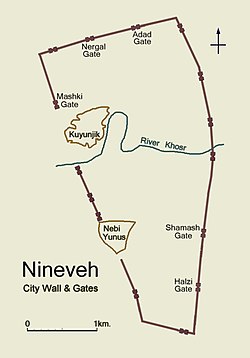Nineveh
Nineveh was an ancient Assyrian city on the eastern side of the Tigris River. It was the capital of the Assyrian Empire.[1] Its ruins are across the river from the modern-day city of Mosul, Iraq.[2]
 | |
| Coordinates: 36°21′34″N 43°09′10″E / 36.35944°N 43.15278°ECoordinates: 36°21′34″N 43°09′10″E / 36.35944°N 43.15278°E |
The ruins of Nineveh are surrounded by the remains of a massive stone and mudbrick wall dating from about 700 BC. The wall was bout 12 km in length. The stone retaining wall had projecting stone towers spaced about every 18 m. The stone wall and towers were topped by three-step parapets.
The city wall had fifteen monumental gateways. They were checkpoints for people entering and exiting the city. They probably had barracks and armouries. With the inner and outer doors shut, the gateways were fortresses. The gateways had passages and interior chambers lined with finely cut stone. A stairway led from one of the interior chambers to the top of the mudbrick wall.
The city wall was destroyed by ISIS by February 2015 during an effort to destroy historical buildings and monuments in the province by the jihadist rebel group.[3]
Nineveh Media
Artist's impression of Assyrian palaces from The Monuments of Nineveh by Sir Austen Henry Layard, 1853
View of the village of "Nunia" or "Ninive", published by Carsten Niebuhr in 1778
Bronze head of an Akkadian ruler, discovered in Nineveh in 1931, presumably depicting Sargon of Akkad's son Manishtushu, c. 2270 BC, Iraq Museum. Rijksmuseum van Oudheden
Artist's impression of a hall in an Assyrian palace from The Monuments of Nineveh by Sir Austen Henry Layard, 1853
Refined low-relief section of a bull-hunt frieze from Nineveh, alabaster, c. 695 BC (Pergamon Museum, Berlin)
Relief of Ashurbanipal hunting a Mesopotamian lion, from the Northern Palace in Nineveh, as seen at the British Museum
The walls of Nineveh at the time of Ashurbanipal. 645–640 BC. British Museum BM 124938.
The Prophet Jonah before the Walls of Nineveh, drawing by Rembrandt, c. 1655
References
| Wikimedia Commons has media related to Lua error in Module:Commons_link at line 62: attempt to index field 'wikibase' (a nil value).. |
- ↑ 2 Kings 19:36
- ↑ Menko Vlaardingerbroek 2004. The founding of Nineveh and Babylon in Greek historiography. Iraq, vol. 66, Nineveh. Papers of the 49th Rencontre Assriologique Internationale, Part One, pp. 233-241.
- ↑ "ISIS has blown up the historic wall of Nineveh". Archived from the original on January 20, 2019. Retrieved March 2, 2015.
+{{{1}}}−{{{2}}}










